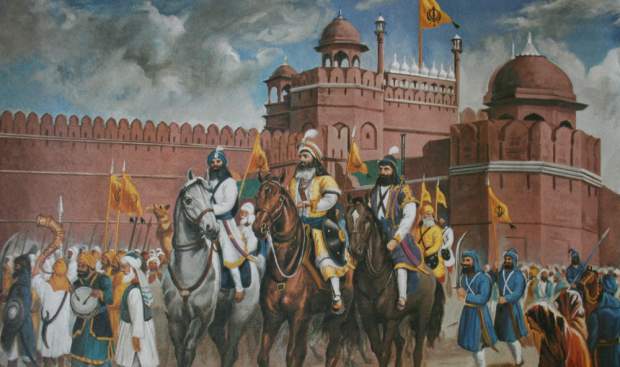
Karora Singh, head of the Karorsinghia Misl, was issue less and had adopted his personal servant, Baghel Singh, as his successor. After the death of Karora Singh in the battle against the Nawab of Kunjpur in 1761, Baghel Singh who belonged to a poor Dhalival Jatt family succeeded him as head of the Karorsinghia Misl .
As well as being a good soldier, Baba Baghel Singh was a very good political negotiator and was able to win over many an adversary to his side. The Mughals, the Ruhilas, the Marathas and British sought his friendship.
Then Baba Baghel Singh turned his attention towards the cis-Yamuna territories. Soon the Sikhs were invading territories in Delhi and beyond, including Meerut, Awadh, collecting tribute from the Nawabs of each area. He is celebrated in Sikh history as the vanquisher of Mughal Delhi. On the 11th of March 1783, the Sikhs entered the Red Fort in Delhi and occupied the Diwan-i-Am (Hall of Public Audience).
It is also commonly believed that Baba Baghel Singh with his army had camped in the jungles surrounding Delhi from which they were planning to secretly launch their attack. The place where the camp was established later came to be known as “Tees Hazaari”. This is where the present day Delhi High Court is located.
Another story goes that the Mughal Emperor when he came to know that Sikhs were planning to attack Delhi, as sufficient quantity of food and other essential commodities were stocked in the fort he ordered that all gates of the fort be closed so that the Sikhs camping in the jungles would soon run out of rations and go back. Some of the Sikhs accidentally came across a mason from the neighbourly village who informed them that a particular place the wall of the fort had caved in from inside though the exterior was intact. He also agreed to lead the Sikh and show them this spot. The Sikhs planned to ram the wall with logs to make a hole in the wall to enter the fort through. This place is now called “Mori Gate” and this where the Inter State Bus Terminus (ISBT) in present Delhi is located.
Baba Baghel Singh had set up an octroi-post near Sabzi Mandi to collect the tax on the goods imported into the city to finance the search and the construction of the Sikh Temples. He did not want to use the cash received from the Government Treasury for this purpose, and most of that was handed out to the needy and poor. He often distributed sweetmeats, bought out of this Government gift, to the congregationalists at the place which, now, is know as the Pul Mithai.


